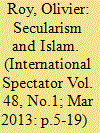| Srl | Item |
| 1 |
ID:
161694


|
|
|
|
|
| Summary/Abstract |
The purpose of this article is to examine what was involved when the great linguist George Grierson framed the history of Indian bhakti in terms of ‘the four churches of the reformation’ in one of his most widely read publications, ‘Bhakti-Mārga’, an entry in the Encyclopaedia of Religion and Ethics (1910). This was his translation of the concept of catuḥ (or cār) sampradāy, which plays a significant role in Nābhādās's Hindi Bhaktamāl (circa 1600). The weight of the target language and its enveloping culture (‘church’, ‘reformation’) raise obvious red flags. Grierson did not submit them to the sort of self-critical scrutiny we might today, nor did he examine the adequacy of Nābhādās's historiography. But did he get it all wrong? I will suggest that there are in fact some intriguing, if distant, analogies between the early modern world out of which Nābhādās wrote and its contemporary Protestant European counterpart, and I will ask whether Nābhādās may have been encouraged to adopt the framework he did because of precedents established in contemporary Muslim historiographical practice. In outlining his four sampradāys, Nābhādas played a role in creating a set of assumptions that long survived his own time in North India—and not just because Grierson would later be listening.
|
|
|
|
|
|
|
|
|
|
|
|
|
|
|
|
| 2 |
ID:
111487


|
|
|
|
|
| Publication |
2012.
|
| Summary/Abstract |
Building on recent literature, this article discusses four ways of studying the relationship between religion and nationalism. The first is to treat religion and nationalism, along with ethnicity and race, as analogous phenomena. The second is to specify ways in which religion helps explain things about nationalism - its origin, its power or its distinctive character in particular cases. The third is to treat religion as part of nationalism, and to specify modes of interpenetration and intertwining. The fourth is to posit a distinctively religious form of nationalism. The article concludes by reconsidering the much-criticised understanding of nationalism as a distinctively secular phenomenon.
|
|
|
|
|
|
|
|
|
|
|
|
|
|
|
|
| 3 |
ID:
119489


|
|
|
|
|
| Publication |
2013.
|
| Summary/Abstract |
Does the integration of Islam in Europe presuppose a prior 'religious reformation' that would make Islam compatible with so-called 'European values'? The wave of religious revival that has touched the new generations of Muslims in Europe is not a return to traditional religious practices but, on the contrary, a recasting of religious norms and values in a European context. Fundamentalism means deculturation. What we are witnessing is a complex, and often tense, process of formatting Islam into a Western model of relationship between state, religion and society. But this process is taking place precisely at a time when Europe is not sure about its own identity: what does a 'European Christian identity' mean when churches are increasingly empty? Faith and culture have never been so disconnected.
|
|
|
|
|
|
|
|
|
|
|
|
|
|
|
|